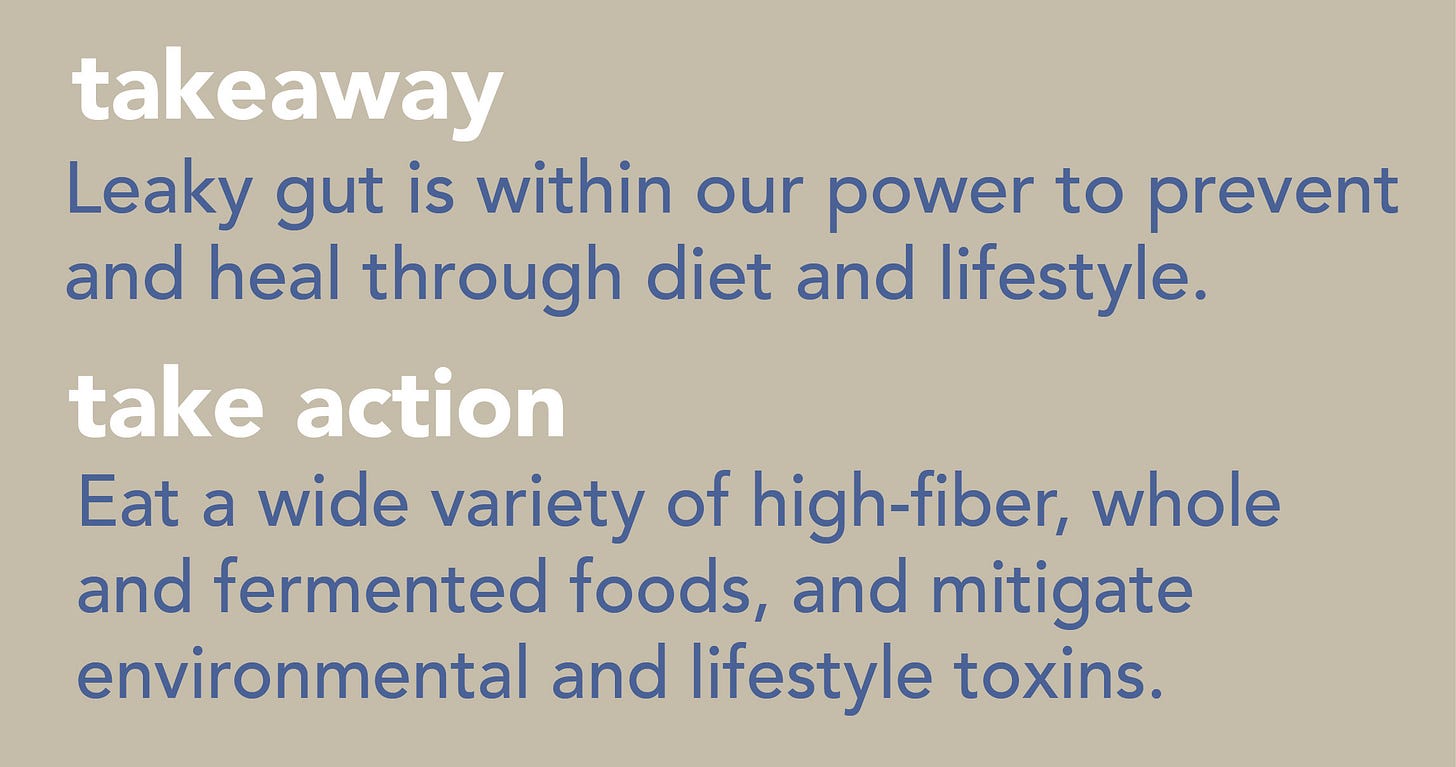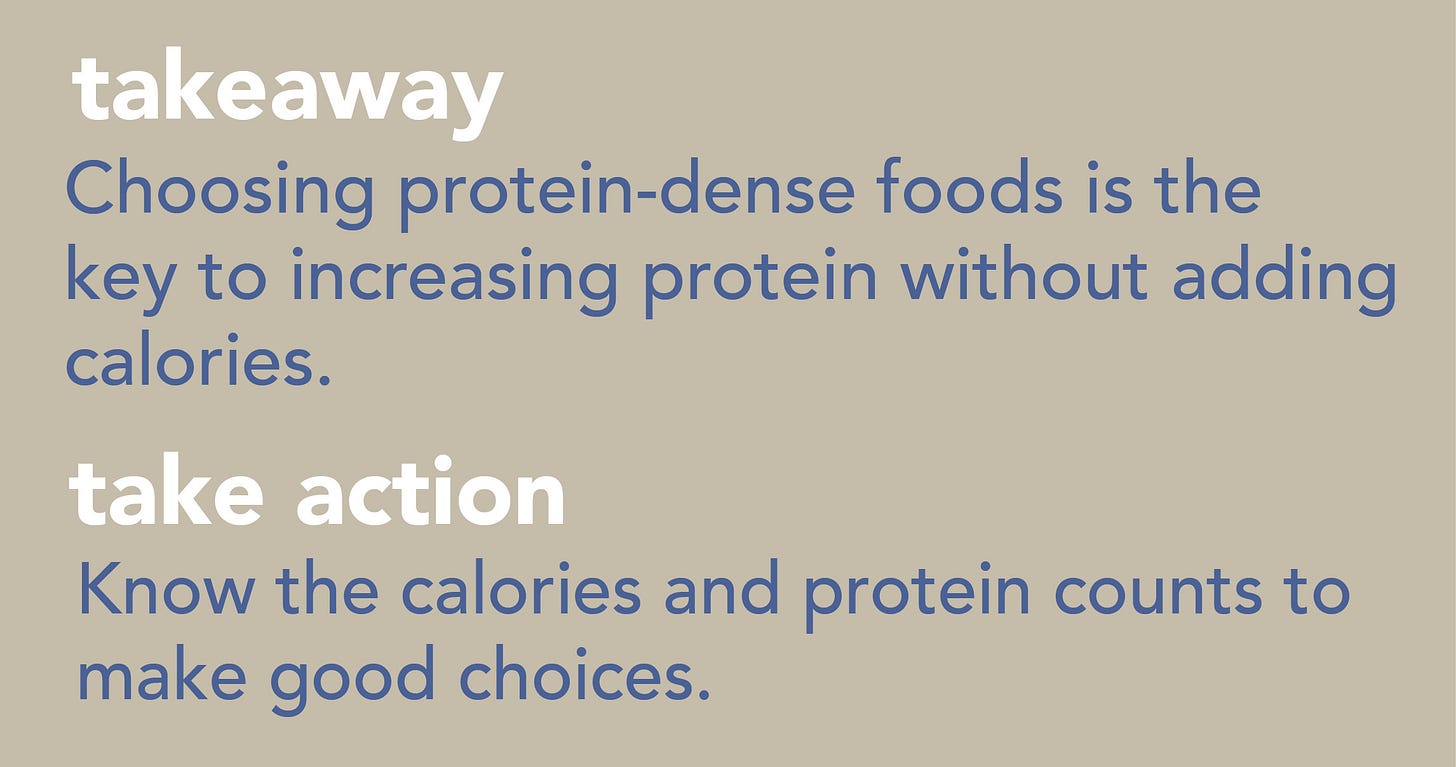Leaky Gut Epiphany, Allergy Meds Caution, Protein Density, Smooth Smoothies
Lightbulbs & Pearls | 019
Leaky Gut Epiphany
The gut and all its millions of bacteria are at the center of many health discussions—and debates—these days. Leaky gut, in particular, could be the culprit behind a range of chronic maladies, from allergies, autoimmune disorders, and chronic fatigue to Crohn’s disease, multiple sclerosis, and type 1 diabetes, to name just a few.
Despite its off-putting name, I’ve endeavored to learn about the syndrome in order to avoid all these pitfalls. However, the information about the root cause of intestinal permeability never really clicked until Andrea and I watched the new Netflix documentary “Hack Your Health: The Secrets of Your Gut.” Notwithstanding the fact that I loathe the word “hack,” I found the film very engaging and informative and came away with a leaky gut epiphany.
The gut is home to a vast and diverse community of beneficial (as well as unbeneficial) bacteria that require proper care and feeding to thrive. If these microscopic organisms go hungry, they turn to their neighboring species for nourishment, which is sometimes the bacteria that form the gut’s protective lining. As the ravenous organisms nibble away at the lining, little holes are created, and voilà: bacterial toxins and undigested food normally contained within the gut can now leak into the bloodstream, potentially causing inflammation and leading to an immune response throughout the body.
What foods do our bacteria friends enjoy? In a nutshell, whole foods, especially fiber (including nuts). Fruits, vegetables, legumes, fermented foods, and whole grains. Essentially, food in its original form, not processed like the thousands of products that fill our grocery store shelves. It’s easy to understand that a diet woefully lacking in nutritious, whole food gives beneficial bacteria no other option than to turn to other sources for nourishment…like the gut lining.
This hypothesis makes perfect sense given the glut of gut-harming ultra-processed packaged foods that have replaced our ancestral sources of nutrition. Compounded by all the environmental and lifestyle stressors that impact our sleep and the levels of toxins in our bodies, chronic illness and disease are on the rise with no end in sight. Our focus should be on safeguarding and nurturing the thriving population of bacteria before they turn on each other.
As a side note, while the gut microbiome is an emerging field of study and leaky gut technically isn’t recognized by mainstream medicine, a growing number of studies support the notion of healing—and possibly reversing—the syndrome through diet, lifestyle, and supplementation.
Allergy Meds Caution
Allergy season is upon us, and depending on where you live, the condition can significantly impact your life. Here in the Favilli house, we are currently trying to wrest control of our son’s allergies, which have not only made him downright miserable but also more susceptible to viruses that come within 10 feet of him.
Regrettably, I am not the guiding influence on his health that I hoped to be (maybe he will be a late bloomer). Since he isn’t one to adhere to a clean lifestyle, diet, or supplements, I acquiesced and sent him to the ENT to tamp down this raging problem. He was promptly loaded up with all the big gun allopathic remedies: prescription steroid spray, Flonase, Claritin, and Allerflo.
Fortunately for Alessio, this will be a short-lived course. People who regularly use allergy meds, however, should know that these medications have surprising side effects that can potentially affect blood pressure and even cholesterol levels. (I know, another thing to worry about!)
According to information from Dr. Amber Belt, many of the traditional antihistamines fortunately don’t impact high blood pressure; it’s the ones with a “D” for the pseudoephedrine decongestant (Claritin-D, Allegra-D, Sudafed) that require caution. Interestingly, pseudoephedrine’s molecular structure is similar to an amphetamine, which stimulates a fight or flight response and raises blood pressure.
While nasal steroids such as Flonase and Nasocort are generally considered “safe” for people managing high blood pressure, if someone is typically sensitive to medications, the nasal steroids may nevertheless have the potential to increase blood pressure numbers. Oral steroids, on the other hand, definitely may increase blood pressure because they cause fluid retention.
Oral steroids will also increase total cholesterol, triglycerides, and LDL cholesterol levels. And (fexofenadine/Allegra) has been shown to also increase LDL cholesterol. Fortunately, steroids are usually taken for a short, finite period of time and don’t cause long-term issues. If you take Allegra and have registered an increase in your LDL, you may consider discontinuing its use before taking other measures.
If you are interested in Dr. Belt's natural approach to allergies, click here to read her post.
Protein Density
We often hear about getting enough protein for overall good health, especially as we age. Unfortunately, the recommended 0.36 to 0.45 grams per pound for the average adult—which can increase to 1.2 grams to lose weight or build muscle—can be daunting. I’ve often thought I simply can’t eat enough daily to get the protein my body needs.
Enter protein density. Simply put, this is the amount of protein in a given number of food calories. It's calculated by dividing the protein by the calories and multiplying by 100. For example, a 1/2 cup serving of low-fat cottage cheese has 14 grams of protein and 81 calories. The magic equation looks like this: 14 ÷ 81x100=17.8, which means its protein density score is 17.8.
In choosing protein-rich foods, aim for a score above 10. As a comparison, a 3 oz. chicken breast has a protein density of 18, sirloin steak scores a 16, and salmon clocks in at 10.9, barely nudging out edamame at 10.3. Surprisingly, 3 oz. of hamburger and ½ cup of tofu are nearly tied at 12.1 and 12.0, and a 3 oz. pork loin and 1 cup of grilled mushrooms both carry the same value of 11.3, while a vegetable such as green beans is less than half as much at 5.3.
Eggs are a great example of how you can make this counting work for you. A whole egg has a density of 8.7 for 72 calories. An egg white has a whopping protein density score of 21.2 for 17 calories. Let’s say you eat two eggs; that’s 144 calories with a density score of 15. Now let’s suppose you have one whole egg and two egg whites. Those numbers are quite different: 106 calories with a protein density score of 51.1!
Translating that to actual protein content, two eggs have 12.56 grams of protein in 144 calories, while the latter blend of whole egg and egg whites has 13.48 grams of protein in 106 calories.
It’s important to note the density score is not how many grams of protein contained in a food, but rather the protein per calorie density.
Selecting high-density protein foods that don’t drastically increase calories is invaluable if you’re trying to maintain or lose weight and/or gain muscle.
The website, Nutrition Over Easy, has a helpful protein density list to get you started.
Smooth Smoothies
Speaking of seasons and protein, with the warmer weather comes morning smoothies several times a week. I’ve developed a recipe that both my husband and I really like: a simple protein concoction of unflavored A2 Kefir (high in probiotics, protein and no need to dilute with other liquid), a heaping scoop of vanilla whey protein, frozen organic wild blueberries and frozen strawberries (no need for ice), and half a banana.
I’ve honed my eyeballing and layering technique (this is an art form), so most mornings, the blending goes very smoothly, with one exception: the frozen strawberries. Often, they are simply too big to grind well, and even though I let the blender run for a couple of minutes, the errant chunk of frozen strawberry sneaks through.
The solution is to buy fresh strawberries, cut them into blendable pieces, and freeze them myself. I grew up with blackberry bushes (in Tucson, of all places), and we froze much of the harvest, so I know the secret to freezing fruit: spread the pieces out on a sheet pan and pop the tray in the freezer. They freeze individually without sticking together and are perfect for storing and blending. I store mine in silicone bags, but you can use any plastic bags.
This route is a win-win. It’s more economical; I can choose the quality of the strawberries, control the processing, and enjoy a smoother smoothie.
Happy freezing and smoothly blending!













